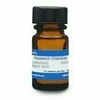Fluorescein Diacetate (syn: FDA) is an esterase substrate that can permeate cells and acts as a viability probe that measures both enzymatic activity (needed to activate its fluorescence) and cell-membrane integrity (required for intracellular retention of the fluorescent product). Upon hydrolysis by intracellular esterases, this compound yields fluorescein which is fluorescent green in living cells. Dead cells cannot accumulate or hydrolyse FDA and remain unstained. Fluorescein diacetate can be used as a fluorogenic substrate for hGSTP1-1.
FDA can be used in diagnostic assays, manufacturing, hematology, and histology.
FDA is soluble in water, ethanol, chloroform, dichloromethane or DMSO.
| Mechanism of Action | Fluorescein Diacetate is an esterase substrate. Upon hydrolysis by intracellular esterases, the compound is hydrolyzed to Fluorescein, which is a green fluorescent compound. |
| Molecular Formula | C24H16O7 |
| Microbiology Applications |
FDA hydrolysis is a simple way to measure total microbial activity in a range of environmental samples, including soils. |
| Eukaryotic Cell Culture Applications |
FDA can be used as a cell viability stain. |
| Plant Biology Applications |
Fluorescein Diacetate (FDA) can be used to determine the viability of cultured plant cells. Researchers at University of Illinois used FDA with suspension cell cultures of tobacco (Nicotiana tabacum), rice (Oryza sativa), soybean (Glycine max (soybean), carrot (Daucus carota), and tomato (Lycopersicon esculentum). A drop of the culture medium containing FDA was mixed with a drop of cells on a microscope slide and viewed after 5 minutes. FDA was suitable for viable cells. The dye was specific, whether the cells were from cultures of different ages, of different species or if the cells had been treated in various ways. Cell viability was confirmed by observing cyclosis and plasmolysis, and whether the cells could grow further when cultured (Widholm, 2009). |
| Cancer Applications |
FDA can be used in cancer research studies. Pi class glutathione S transferase (FSTP1) is highly expressed in various cancerous cells, and is a marker of malignant and pre-malignant cells. FDA is fluorescently activated by esterolytic activity of human hGSTP1. Since GSTP1 is highly expressed in various types of cancer cells, improving the fluorogenic substrates to be more selective should lead to development of tools for detecting GSTP1-overexpressing cancer cells and investigating the biological functions of GSTP1 (Fujikawa et al, 2018). |
| References |
Adam G and Duncan H (2001) Development of a sensitive and rapid method for the measurement of total microbial activity using fluorescein diacetate (FDA) in a range of soils. Soil Biol. and Biochem. 33 (7-8):943-951 Fujikawa Y, Nampo T, Mori M, Kikkawa M, Inoue H. Fluorescein Diacetate (FDA) and its analogue as substrates for Pi-class glutathione S-transferase (GSTP1) and their biological application. Talanta. 2018 Mar 1;179:845-852 PMID 29310316 Widholm JM (2009) The use of Fluorescein Diacetate and phenosafranine for determining viability of cultured plant cells. Stain Technol. 47:4, 189-194 |





